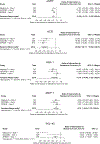Urinary Biomarkers and Kidney Injury in VA NEPHRON-D: Phenotyping Acute Kidney Injury in Clinical Trials
- PMID: 37726051
- PMCID: PMC10841767
- DOI: 10.1053/j.ajkd.2023.07.012
Urinary Biomarkers and Kidney Injury in VA NEPHRON-D: Phenotyping Acute Kidney Injury in Clinical Trials
Abstract
Rationale & objective: Urinary biomarkers of injury, inflammation, and repair may help phenotype acute kidney injury (AKI) observed in clinical trials. We evaluated the differences in biomarkers between participants randomized to monotherapy or to combination renin-angiotensin-aldosterone system (RAAS) blockade in VA NEPHRON-D, where an increased proportion of observed AKI was acknowledged in the combination arm.
Study design: Longitudinal analysis.
Setting & participants: A substudy of the VA NEPHRON-D trial.
Predictor: Primary exposure was the treatment arm (combination [RAAS inhibitor] vs monotherapy). AKI is used as a stratifying variable.
Outcome: Urinary biomarkers, including albumin, EGF (epidermal growth factor), MCP-1 (monocyte chemoattractant protein-1), YKL-40 (chitinase 3-like protein 1), and KIM-1 (kidney injury molecule-1).
Analytical approach: Biomarkers measured at baseline and at 12 months in trial participants were compared between treatment groups and by AKI. AKI events occurring during hospitalization were predefined safety end points in the original trial. The results were included in a meta-analysis with other large chronic kidney disease trials to assess global trends in biomarker changes.
Results: In 707 participants followed for a median of 2.2 years, AKI incidence was higher in the combination (20.7%) versus the monotherapy group (12.7%; relative risk [RR], 1.64 [95% CI, 1.16-2.30]). Compared with the monotherapy arm, in the combination arm the urine biomarkers at 12 months were either unchanged (MCP-1: RR, -3% [95% CI, -13% to 9%], Padj=0.8; KIM-1: RR, -10% [95% CI, -20% to 1%], Padj=0.2; EGF, RR-7% [95% CI, -12% to-1%], Padj=0.08) or lower (albuminuria: RR, -24% [95% CI, -37% to-8%], Padj=0.02; YKL: RR, -40% to-44% [95% CI, -58% to-25%], Padj<0.001). Pooled meta-analysis demonstrated reduced albuminuria in the intervention arm across 3 trials and similar trajectories in other biomarkers.
Limitations: Biomarker measurement was limited to 2 time points independent of AKI events.
Conclusions: Despite the increased risk of serum creatinine-defined AKI, combination RAAS inhibitor therapy was associated with unchanged or decreased urinary biomarkers at 12 months. This suggests a possible role for kidney biomarkers to further characterize kidney injury in clinical trials.
Plain-language summary: The VA NEPHRON-D trial investigated inhibition of the renin-angiotensin-aldosterone system (RAAS) hormonal axis on kidney outcomes in a large population of diabetic chronic kidney disease patients. The trial was stopped early due to increased events of serum creatinine-defined acute kidney injury in the combination therapy arm. Urine biomarkers can serve as an adjunct to serum creatinine in identifying kidney injury. We found that urinary biomarkers in the combination therapy group were not associated with a pattern of harm and damage to the kidney, despite the increased number of kidney injury events in that group. This suggests that serum creatinine alone may be insufficient for defining kidney injury and supports further exploration of how other biomarkers might improve identification of kidney injury in clinical trials.
Keywords: AKI; RAAS-I; albuminuria; biomarkers; creatinine.
Copyright © 2023 The Authors. Published by Elsevier Inc. All rights reserved.
Conflict of interest statement
The other authors declare that they have no relevant financial interests.
Figures


Comment in
-
Combined Angiotensin Inhibition for CKD: The Truth Is Rarely Pure and Never Simple.Am J Kidney Dis. 2024 Feb;83(2):130-132. doi: 10.1053/j.ajkd.2023.10.003. Epub 2023 Dec 9. Am J Kidney Dis. 2024. PMID: 38069999 Free PMC article. No abstract available.
References
Publication types
MeSH terms
Substances
Grants and funding
- U01 DK114866/DK/NIDDK NIH HHS/United States
- UL1 TR001863/TR/NCATS NIH HHS/United States
- R37 DK039773/DK/NIDDK NIH HHS/United States
- R01 DK072381/DK/NIDDK NIH HHS/United States
- U01 DK129984/DK/NIDDK NIH HHS/United States
- R01 DK128087/DK/NIDDK NIH HHS/United States
- U01 DK085660/DK/NIDDK NIH HHS/United States
- R01 HL085757/HL/NHLBI NIH HHS/United States
- R01 DK093770/DK/NIDDK NIH HHS/United States
- P30 DK079310/DK/NIDDK NIH HHS/United States
- U01 DK106962/DK/NIDDK NIH HHS/United States
- U01 DK102730/DK/NIDDK NIH HHS/United States
- R01 DK039773/DK/NIDDK NIH HHS/United States
- K23 DK117065/DK/NIDDK NIH HHS/United States
LinkOut - more resources
Full Text Sources
Other Literature Sources
Research Materials
Miscellaneous

